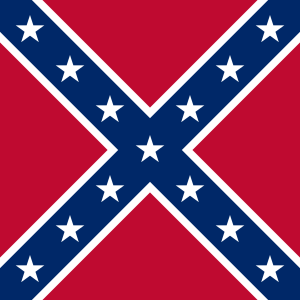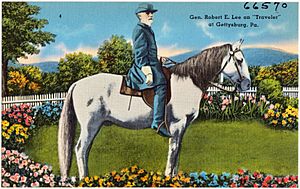Army of Northern Virginia facts for kids
The Army of Northern Virginia was the main fighting force for the Confederate States in the eastern part of the American Civil War. It was the most successful Confederate army during the war. This army often fought against the Union Army of the Potomac.
Several generals led the army in its early days. But it became most famous under its final leader, General Robert E. Lee. He took command in June 1862. Because of him, people often called it "Lee's army."
Contents
History of the Army
The army was first called the (Confederate) Army of the Potomac. It was officially formed on October 22, 1861.
General P. G. T. Beauregard first commanded the "Alexandria Line" on May 31, 1861. He joined his troops near Manassas, Virginia, on June 2. Beauregard planned to attack Washington, D.C.. This meant pushing the Union army back behind Bull Run. He asked for more help from Joseph E. Johnston's army in the Shenandoah Valley.
On July 21, 1861, Beauregard tried a surprise attack on Union forces. It did not work at first. He was pushed back until the afternoon. Then, Johnston's troops arrived by train. The Confederates were able to push the Union forces back. They turned a near-disaster into a victory. Both Beauregard and Johnston were full generals. Johnston took command of the two armies, which were now combined.
Confederate President Jefferson Davis did not get along with Beauregard. They had many disagreements after Johnston took command. Maybe because of this, Beauregard was sent west in January 1862. He became second in command in the Army of Mississippi.
During the Battle of Seven Pines, Johnston was hurt. Jefferson Davis then chose Lee to take over. In June 1862, when Lee took command, the army was a mix of different groups in Virginia and North Carolina. This was also when the army had its largest number of soldiers, about 90,000. When Lee replaced Johnston, his orders were for the "Department of Northern Virginia" and the "Army of Northern Virginia." From then on, that was its name.
The Army Under Lee
Lee wanted to inspire his troops. He told them they would "maintain the ancient fame of the Army of Northern Virginia." He also said they would "conquer or die." The army was new, so it had no "ancient history." But Lee's words still motivated them.
The first battles under Lee were called the Seven Days Battles. These battles showed what Lee's army was like. His soldiers were tough and dedicated. They were willing to fight hard and suffer many casualties to win.
Between 1861 and 1865, the Army of Northern Virginia fought in many battles. Some famous ones include the Battle of Antietam, the Battle of Chancellorsville, and the Battle of Gettysburg. In the Battle of Fredericksburg, Lee's army caused 12,653 Union casualties. They only lost 5,377 men themselves.
In December 1861, Lee told one of his officers after a fight, "Go after them, and damage them all you can!" In the months after Lee took over, his army pushed the Union army away from Richmond, Virginia. They also drove them out of Virginia. Lee became a hero to his soldiers and the people of Virginia.
Antietam and the Maryland Campaign
Antietam was the third of four battles in Lee's Maryland Campaign. It was fought on September 17, 1862. It was the bloodiest single-day battle of the Civil War. The Army of Northern Virginia had about 10,320 casualties (killed, wounded, or missing). The Union Army of the Potomac had about 12,400 casualties.
Lee wanted the Army of Northern Virginia to invade the Northern states of Maryland and Pennsylvania. This would threaten the cities of Washington, D.C. and Baltimore. Lee hoped that a series of big victories would make England and France recognize and support the South. He also hoped it might make Abraham Lincoln ask for peace.
In September, Lee moved his army north. They captured the garrison at the Battle of Harpers Ferry. Lee's army was pushed back at the Battle of South Mountain. They then pulled back again after a day of heavy fighting at Antietam.
Lee's army retreated back into Virginia. He managed to stop the Union Army of the Potomac from chasing them. This happened with a successful action at the Battle of Shepherdstown. From a military view, Antietam was a tie. But it gave Lincoln a chance to claim a victory. He used this to issue his Emancipation Proclamation.
Chancellorsville
At Chancellorsville, Lee's army defeated the Army of the Potomac again. This time, they caused 16,800 Union casualties while losing 13,000 men. The victory at Chancellorsville gave new hope to the South. It made them believe that one big blow to the North could win the war.
Lee's soldiers and officers respected him greatly. They trusted his decisions and thought he was a military genius. At the same time, the Union Army of the Potomac had low spirits under General Joseph Hooker. Again and again, the Army of Northern Virginia, with fewer men and resources, beat the larger Union army. Lee carefully watched Northern newspapers for any information about his enemy.
Gettysburg
Gettysburg was Lee's next chance to strike a final blow to win the war. The battle was fought from July 1 to July 3, 1863. This time, Lee suffered more casualties than his army could afford. The battle at Gettysburg ended Lee's invasion of the North. It also nearly destroyed the Army of Northern Virginia. After this, the war began to turn in favor of the Union.
The battle also showed another side of the Army of Northern Virginia's actions. As the Confederate army moved north into Pennsylvania, soldiers gathered up escaped slaves and free black people. African-Americans, including men, women, and children, were taken with the army as they marched north. When the Army of Northern Virginia retreated, they took these captured black people, over a thousand, back to Virginia. There, those who had escaped slavery were returned to their owners. Others were sold or put in prison.
Lee may not have ordered these actions. Once in Pennsylvania, he told his troops that harming unarmed people or destroying private property would be a "disgrace" to the army. It would also hurt the Confederate cause. However, his officers and men still gathered black people. In one case in Mercersburg, Pennsylvania, soldiers threatened to burn houses that hid black people. They gave people 20 minutes to give up any black people in their homes.
Appomattox
In mid-May 1864, there were rumors that the Army of Northern Virginia was beaten. A Union officer on General George G. Meade's staff disagreed. He said, "Lee is a brave and skillful soldier and he will fight while he has a division or a day's rations left." About Lee's soldiers, he said, "These rebels are not half-starved and ready to give up—a more sinewy, tawny, formidable-looking set of men could not be."
This officer knew they were still a deadly fighting force. This was true even after three years of hard war against a larger and better-equipped army. It took another 11 months of hard fighting before the Army of Northern Virginia finally surrendered at Appomattox.
Images for kids
See also
 In Spanish: Ejército de Virginia del Norte para niños
In Spanish: Ejército de Virginia del Norte para niños














